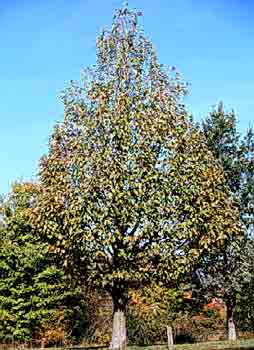 Cucumbertree Magnolia - Magnolia acuminata
Cucumbertree Magnolia - Magnolia acuminata
Magnolia Family (Magnoliaceae)
- Native habitat: Eastern U.S., scattered in deciduous woods; a Kentucky native.
- Growth habit: Pyramidal when young, becomes broad with age.
- Tree size: This magnolia is a fast-growing tree and is one of the largest (50 to 80 feet) of our native species; spread is comparable to height.
- Flower and fruit: Three-inch flowers are yellow-green and blend with new foliage. Fruit is a pinkish-red, cob-like seed cone.
- Leaf: The deciduous leaves are smaller than those of other native magnolias. The distinctive, thin leaf has a sharply pointed end. Fall color is yellow, but not significant.
- Hardiness: Winter hardy to USDA Zone 4.
Cultivars of cucumbertree have been selected for some time, but have failed to become important in the nursery industry. They have been selected for shape and yellow flower color. Selected cultivars include:
- 'Urbana,' 'Large Yellow' and 'Miss Honeybee.'
The hybrids of cucumbertree have proved more important commercially. The most exciting hybrids are from M. acuminata and M. denudata. These are crosses that involve the smaller, shrubby form of M. acuminata var. subcordata. These numerous crosses have produced winter hardy, large, yellow-flowered magnolias. They are very attractive and appear to bloom more reliably than saucer magnolia (M. x soulangiana) in areas with early springs and late frosts. Cultivars of M. acuminata x M. denudata include:
 ‘Butterflies,' ‘Elizabeth,' ‘Goldfinch' and ‘Sundance.'
‘Butterflies,' ‘Elizabeth,' ‘Goldfinch' and ‘Sundance.'
Hybrids have also been made from M. acuminata and other magnolia species. These include M. liliiflora, M. sprengeri and M. x soulangiana. It remains to be seen how important these become in the trade.
 Unlike our other native magnolias, the large cucumbertree is an excellent shade tree, casting dense shade with tropical-like leaves. It has a beautiful symmetrical form and spreading branches. Although the greenish flowers may be obscured by spring foliage, the fruit cones are distinctive when green or when mature in early fall. Cucumbertree has attractive winter buds covered with long, silky hairs. It also has furrowed bark, unique among American magnolias.
Unlike our other native magnolias, the large cucumbertree is an excellent shade tree, casting dense shade with tropical-like leaves. It has a beautiful symmetrical form and spreading branches. Although the greenish flowers may be obscured by spring foliage, the fruit cones are distinctive when green or when mature in early fall. Cucumbertree has attractive winter buds covered with long, silky hairs. It also has furrowed bark, unique among American magnolias.
Early Americans flavored whiskey with the bitter, immature fruit, which was used medicinally for fevers. The wood of the cucumbertree is similar to that of its cousin, the tulip poplar, and is frequently sold as such. The wood is used for boxes, crates, furniture, doors and Venetian blinds.
 Magnolias were among the first flowering plants to appear on earth. Their range once included many parts of Europe, Canada, Siberia and Greenland. This genus is now limited to eastern Asia, eastern North America and the Himalayas. The specific epithet, acuminata, refers to the cucumbertree's pointed leaf tips. The trunk and flowers of cucumbertree show its relationship to tulip poplar (Liriodendron), but the fruits are typical of the magnolia family. The immature green fruit resembles a cucumber and leads to the common name.
Magnolias were among the first flowering plants to appear on earth. Their range once included many parts of Europe, Canada, Siberia and Greenland. This genus is now limited to eastern Asia, eastern North America and the Himalayas. The specific epithet, acuminata, refers to the cucumbertree's pointed leaf tips. The trunk and flowers of cucumbertree show its relationship to tulip poplar (Liriodendron), but the fruits are typical of the magnolia family. The immature green fruit resembles a cucumber and leads to the common name.
Virginia botanist John Clayton introduced the cucumbertree into cultivation in 1736. Shortly thereafter, English naturalist John Bartram sent cucumbertree seeds to England, which started a new rage. Botanist Francois Michaux subsequently came to North America to collect enough seed to satisfy the growing European demand for this hardy new magnolia species.
The name Magnolia is in honor of 18th century French botanist Pierre Magnol who established the renowned Montpellier Botanical Garden.



